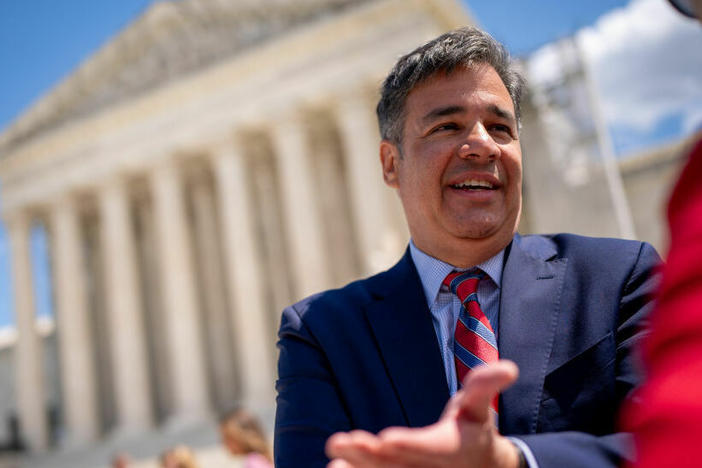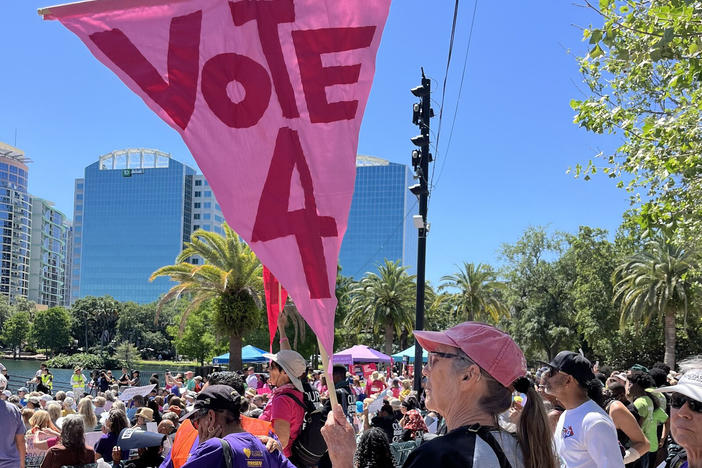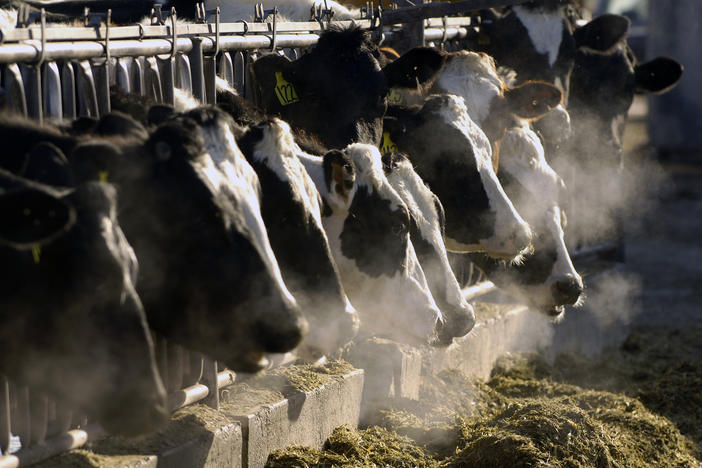Section Branding
Header Content
'Now Is Not The Time To Stop Wearing A Mask,' Says CDC Director Rochelle Walensky
Primary Content
With new cases teetering at about 60,000 to 70,000 per day, new hyper-transmissible variants and state rollbacks of coronavirus restrictions, the CDC chief urges Americans to remain vigilant.
Transcript
ARI SHAPIRO, HOST:
Dr. Rochelle Walensky has been head of the CDC for just over a month. And for most of that time, she was looking at hopeful signs - a sharp drop in new coronavirus cases, more people getting vaccinated and a third vaccine coming on the market. Now, it's starting to look like a mixed picture. New cases and deaths are creeping up. Texas and Mississippi are dropping statewide mask requirements and fully reopening for business.
And CDC director Rochelle Walensky is here to talk with us about where we are in the fight against this pandemic. Welcome to ALL THINGS CONSIDERED.
ROCHELLE WALENSKY: Thanks so much for having me.
SHAPIRO: Can we just start with the numbers and what you're seeing? There's fear that we might be at the start of another surge driven by these more transmissible variants. Where are we right now?
WALENSKY: You know, I think we got accustomed to things being so incredibly high for the months of December and January. We were over 200,000 cases a day, over 3,000 deaths a day - clearly unacceptable levels. And we've been fortunate to watch those levels decline over the last several weeks.
What worries me the most is that we're really stabilizing now, teetering at around 60- to 70,000 cases a day, and that is too many cases to try and put an end to this pandemic. It also worries me because as we're sort of stabilizing at these very high levels of virus, we have this hyper-transmissible strain, the B.1.1.7 strain, that really threatens the progress that we've been making to date. And so with these levels of virus circulating and this hyper-transmissible strain, I'm just worried about what the future looks like.
SHAPIRO: Just to be clear, are we seeing a plateau - a leveling off - or are we actually starting another upswing?
WALENSKY: I think it's a little bit too early to tell. We're watching this very carefully. We're, you know, teetering at around 1%, 2%, 3% increases. You know, numbers change a little bit over the weekend. There's less testing, less reporting that happens on the weekend. So we're cautious. But I think it's too hard to tell right now whether we're just seeing a leveling off or a resurgence.
SHAPIRO: And do we have enough data? Are we doing enough testing to know how quickly these new, more transmissible variants may be spreading in the U.S.?
WALENSKY: Right. We have been doing a lot of work to try and scale up our surveillance screening. So when I came in, we were testing only about 250 samples a week for surveillance for these variants. Now, we're up to somewhere between 9- to 15,000 surveillance tests a week. And we're working hard over the next few weeks ahead to ensure more and more surveillance testing. And of course, as you suggest, the more surveillance we're doing, the more of these variants we're finding.
SHAPIRO: Let me ask you about the decisions by Texas and Mississippi to end mask requirements and fully reopen. You've warned that now is not the time. Today, President Biden called it Neanderthal thinking. What are you afraid is going to happen?
WALENSKY: You know, the CDC squarely recommends routine masking, routine social distancing right now, right as we're at this nexus, this critical time, this tenuous point. So it squarely does not fit within the guidance that we are recommending. I will say, though, that the reason that I mask is not because my governor tells me so. The reason I mask is because I know it protects myself, it protects my loved ones, it protects my neighbors and my community. So I think everybody is empowered to do the right thing and to put the mask on.
SHAPIRO: The governors of these states are clearly responding to a sense of exhaustion that they perceive among the people of their state. And I wonder how you think the CDC can connect with that sentiment, show empathy for people who are just tired of masks and distancing and make sure people don't reject your message that this fight is still a long way from over.
WALENSKY: It's such an important point. We are all exhausted. I can tell you folks in the response at CDC are exhausted. We are all exhausted. And this is not the message that I want to be sending as I first enter into this new position.
Here's what I think is the important thing. Six months ago, we didn't see any vision of what the future might look like. But today, the day after the president announced that by the end of May, we will have enough vaccine to vaccinate the entire country, there is a vision that there's a light at the end of the tunnel, that we could vaccinate the entire country, that we really could get to a place where we don't have so much virus circulating. And so today, in my mind, is not the time to relax these things as exhausted as we all are because we do really see that real promise of getting to vaccinate everyone.
I think the next two or three months could go in one of two directions. If things open up, if we're not really cautious, we could end up with a post-spring break surge the way we saw a post-Christmas surge. We could see much more disease. We could see much more death. And in an alternative vision, I see we really hunker down for a couple of more months, we get so many people vaccinated and we get to a really great place by summer. And what I'm just encouraging people to do, despite the exhaustion - and I feel it, too - is to share the vision of that second place.
SHAPIRO: So let's talk about this promise or forecast that President Biden offered this week - that by the end of May, there may be enough vaccine supply for every adult in the United States. That's not quite the same as saying that every adult in the U.S. will be vaccinated by the end of May. Do you have a forecast for how long you expect it to be until everyone who wants a dose of the vaccine can get one?
WALENSKY: Until now, one of the things that has really challenged us is the vaccine supply. We have more people who want vaccine than can get it, and we have less vaccine than we need. What - the hard work that we're doing right now is to imagine that inflection point, which I don't think is too far away. I envision in a couple of weeks, by the end of this month, early to mid-April, that we're going to be in a place where we have a lot of vaccine, and we're going to want people who may be hesitant to get vaccinated to want the vaccine.
And we're doing a lot of work, a lot of outreach, a lot of education, a lot of talking with community-based organizations and faith-based organizations to ensure both that they have a place to get vaccinated and that when the vaccine is ready for them, that people will want it. And so we're really doing a lot of that hard work now, both to ensure that there's adequate vaccinators and vaccination sites and then to ensure that people really are encouraged and want the vaccine.
SHAPIRO: That's something that I hadn't heard - that just in a couple of weeks to a month, the supply of vaccine might have increased enough that we're not going to be in this scarcity crunch the way we are right now.
WALENSKY: I think the supply is going to increase more and more in the weeks ahead. I think end of March looks better, end of April looks even better than that. So I think really we're talking in the four- to eight-week range where we're really going to start seeing a real step up of supply.
SHAPIRO: There has not been much clear guidance about what people can safely do after they've been vaccinated. What can you tell us about what is safe for people who have had their shots?
WALENSKY: I'm looking forward - CDC is releasing guidance on this later - soon, I should say.
SHAPIRO: (Laughter).
WALENSKY: And I'm really looking forward to having that guidance out there so everybody can see what we have to say.
SHAPIRO: Would you like to give us a preview and make some news?
WALENSKY: (Laughter) You know, what I will say is that there have been over 70 million doses of vaccine given, over 50 million of Americans who've received one dose. And yet, only about 7- to 8% of our population has received two doses. So we're taking baby steps to ensure that people - because, you know, we don't have widespread vaccination coverage yet, we want to make sure that we're taking these baby steps so that people don't feel like it's open season, shall we say.
SHAPIRO: I know the CDC has been under a lot of pressure about school reopening. And the president says this is a priority. Given the small number of school children who are in districts that can fully reopen right now, do you think the CDC guidelines are too restrictive?
WALENSKY: You know, the CDC guidelines are intended to be a road map for how schools can and should open. When they were first released in early February, we had so much disease transmission in the country. Those numbers have come down. And in doing so, we've really believed, based on the numbers, that at least, you know, around one in five schools could be opened in full with full in-person learning from all K through 12.
We have a lot of work to do in some of these other areas with more transmission. But in all areas, our guidance suggests that there is a path to get at least some children back to schools in all districts, either in potentially hybrid mode at least for K through five.
SHAPIRO: And then I'd like to ask about the CDC itself because, as you know, during the Trump administration, it came under a lot of political pressure. And instead of taking a leading role in fighting the pandemic, the CDC was often sidelined. You told the Journal of the American Medical Association that scientists at the CDC had been diminished and muzzled. And so what are you seeing now? How do you go about fixing those problems?
WALENSKY: I'm really glad you asked this question. The great news for me is those people who are so amazing and so dedicated and so mission-oriented and so public health-oriented and tireless are still there. And I'm getting to meet all of them. And they're extraordinary people.
They are worried. They are not sleeping because they want all of you to have good health. So it's been really enlightening and invigorating for me to see that the work that they're doing - I think and I hope it's been invigorating for them to know that I appreciate what they're doing is science-driven, and then I'm willing and happy to articulate that science both back with them to discuss the science and then to discuss it with the American people.
SHAPIRO: I know you've got this plaque on your desk that says hard things are hard, or at least that's what I've heard (laughter).
WALENSKY: (Laughter) That is so true.
SHAPIRO: And given the challenge of the task in front of you right now - leading the CDC at a time that the country is exhausted and needs hope and also needs to stay vigilant, and it's the largest vaccine distribution mobilization (laughter) in the last century - among the many hard things you've done in your career, how hard is this?
WALENSKY: You know, I'm not going to lie. This is a really hard job. It's harder than I ever thought it would be. But I have been blessed to not lose loved ones through this pandemic. And so the stuff that I'm doing that's hard for me is not nearly as hard as what the American people have suffered.
SHAPIRO: Dr. Rochelle Walensky is director of the Centers for Disease Control and Prevention.
Thank you so much for your time today.
WALENSKY: Thanks so much.
(SOUNDBITE OF AGNES OBEL'S "MARY") Transcript provided by NPR, Copyright NPR.
Bottom Content



